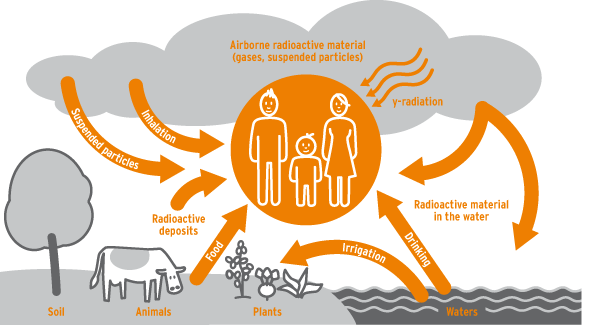Consequences of accident-caused releases
During a severe accident in a nuclear power plant, radioactive material may be released either as gases or as suspended particles. Suspended particles are a mix of fine airborne particles and gases as e.g. are caused during the process of spraying varnish and colouring onto a surface with a spray can.
Radioactive material may lead to radiation exposure of humans in a number of different ways:
- bydirect radiation in the air,
- by direct radiation of deposits on the soil, on houses and possible also clothes,
- by inhalation as well as
- by ingestion of contaminated foodstuffs.
Health effects from radiation exposure are dependent on the absorbed dose, the period over which the dose was absorbed and on the concerned person’s health constitution. The consequences can therefore vary accordingly from one affected person to the next. The higher the dose the more severe is the damage caused by radiation. If there is a high radiation exposure of 300 to over 1,000 millisievert (mSv), severe cell damage can lead to radiation illnesses. In technical usage these are "deterministic radiation effects", which in the case of lower radiation exposure comprise e.g. vomiting, skin burns as well as opacity of the eye lens. If after the absorption of doses of considerably more than 1,000 mSv no medical treatment occurs, fatalities cannot be ruled out.
In addition to these deterministic effects, there is the possibility of developing long-term consequences such as cancer or leukaemia. These illnesses mostly appear years after the radiation exposure and are also referred to as "stochastic radiation effects". In this case it is not the severity of the illness that is dependent on the amount of the dose but the probability of developing such an illness. The radiation therefore increases the probability of developing such an illness.
